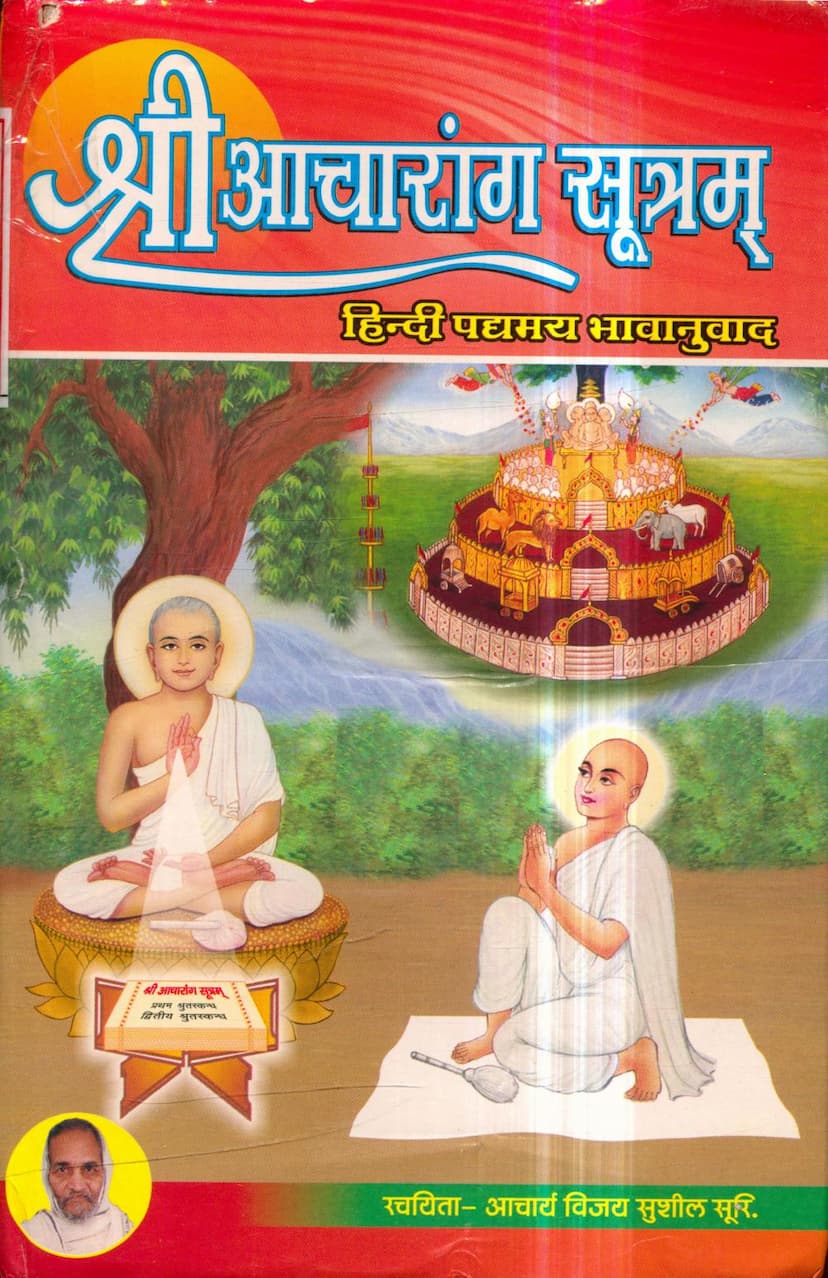Acharang Sutram
Added to library: September 1, 2025

Summary
Here's a comprehensive summary of the provided Jain text, "Acharang Sutram" (Hindi Padyamay Bhavanuvaad), based on the pages you've shared:
Book Title: Shree Acharang Sutram Author(s) (Hindi translation): Acharya Vijay Sushil Suri Editor: Acharya Shrimad Vijay Jinottam Surishwarji M.S. Publisher: Shree Sushil Sahitya Prakashan Samiti, Jodhpur
Overall Purpose and Content:
This book is a poetic Hindi translation and exposition of the Acharang Sutra, the first Anga (part) of the Jain Agamas. The Acharang Sutra is fundamental to Jain philosophy, focusing on the conduct and ethical principles for ascetics (shramanas) and lay followers. This particular edition aims to make these profound teachings accessible through simple and evocative Hindi poetry, enhanced by illustrative pictures.
Key Themes and Highlights:
-
The Acharang Sutra's Significance: The text emphasizes that the Acharang Sutra is the foundational scripture of Jainism, dealing primarily with the conduct (Achara) of monks and nuns. It is considered the first and foremost among the Agamas.
-
The Role of Gurus: The book is dedicated to and inspired by a lineage of revered Jain Acharyas, particularly Acharya Shrimad Vijay Sushil Surishwarji M.S. (the primary translator/commentator) and Acharya Shrimad Vijay Jinottam Surishwarji M.S. (the editor). The introduction and preliminary sections are filled with praise and salutations to these spiritual guides, highlighting their contributions to Jain literature and tradition.
-
Structure and Content Overview:
- Introduction and Preliminary Matter: The initial pages include a cover introduction explaining the imagery of the Samavsaran (the divine assembly where Tirthankaras preach), dedications, salutations to gurus, and biographical information about the main Acharyas involved in its creation.
- The Author's Intent: Acharya Vijay Sushil Suri explains his motivation for creating this poetic translation: to spread the essence of the Acharang Sutra to a wider audience in an easily understandable format, fulfilling the requests of his disciples and following the path of his gurus. He expresses humility regarding his efforts.
- The Acharang Sutra's Anatomy: The text provides a detailed breakdown of the Acharang Sutra's structure, mentioning its original vastness (18,000 gathas) and the current extant portion (around 2,500 gathas). It describes the nine studies (Adhyayanas) within the First Shrutkhanda and briefly outlines the subject matter of each study, including:
- Shastra Parigraha (Weapons/Means of Violence): Discussing various forms of violence and their origins related to the senses and bodily actions.
- Lok Vijaya (Conquering the World): Focusing on detachment from worldly desires, understanding impermanence, and the futility of attachment.
- Shitosniya (Heat and Cold): Emphasizing the endurance of dualities like heat and cold and the importance of equanimity.
- Samyaqtva (Right Faith/Perspective): Discussing the essence of true faith, its importance, and distinguishing it from ignorance.
- Loksaar (Essence of the World): Highlighting the transient nature of the world and the need for renunciation.
- Dhruta (The Detached/Vigilant): Focusing on the characteristics of a detached ascetic, vigilance, and avoiding carelessness.
- Mahapragya (Great Wisdom): (Mentioned as having been lost or disrupted).
- Vimoksha (Liberation): Dealing with various aspects of liberation, including different types of pandit maran (wise death/fasting unto death).
- Upadhana Shruta (Study of Upadana): Describing the conduct, attire, and austerities of Lord Mahavir.
- Poetic Style: The translation is presented in various Hindi poetic meters like Doha, Kundaliya, Ghagnakshari, Manoharan, and others, making the complex philosophical ideas more lyrical and engaging.
- Illustrations: The book features colorful illustrations intended to simplify and visually represent the profound concepts discussed.
- Core Jain Principles Emphasized: Throughout the text, key Jain principles like Ahimsa (non-violence), Sanyam (restraint/discipline), Tyaga (renunciation), Vairagya (detachment), Aparigraha (non-possession), Samayaktva (right faith), and the understanding of Karma are consistently highlighted.
- The Journey of an Ascetic: The Acharang Sutra, as interpreted here, guides the ascetic through the rigorous path of spiritual discipline, from the initial understanding of violence and its causes to the ultimate goal of liberation. It details how to conduct oneself in various situations, including collecting alms, behavior in different environments, and maintaining equanimity amidst hardships.
- The Philosophy of Karma: The text delves into the understanding of karma, its binding nature, and the ways to prevent new karmic influx (samvara) and shed existing karma (nirjara) through righteous conduct and spiritual practices.
- The Nature of Reality: It explores the nature of the soul, the impermanence of the body and worldly possessions, and the path to true and lasting happiness through self-realization and detachment.
- The Life of Lord Mahavir: The Upadhana Shruta section, in particular, touches upon the practices and extreme austerities undertaken by Lord Mahavir, including his patient endurance of physical hardships and insults from people.
In essence, this work is a devotional and educational rendition of a foundational Jain scripture, designed to illuminate the path of spiritual liberation through the teachings of the Acharang Sutra, rendered in the accessible and beautiful medium of Hindi poetry.